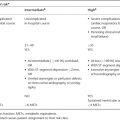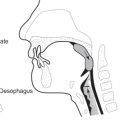Interstitial Lung Disease
Background and Epidemiology
Interstitial lung disease (ILD) refers to a range of pathologies that stimulate an inflammation or fibrosis of the lung interstitium, which comprises the connective tissues of the alveolar and bronchial epithelium and its surrounding vascular and lymphatic tissues. If the interstitium is damaged, efficient gas exchange will not occur.
There is a wide range of conditions that make up the ILDs (Table 49.1), only a few of which can be discussed in this chapter. Many of these increase in prevalence with advancing age. The most common conditions in older adults are idiopathic pulmonary fibrosis (also known as cryptogenic fibrosing alveolitis), hypersensitivity pneumonitis and the pneumoconioses. Although most ILDs increase their prevalence with age, sarcoidosis and chronic eosinophilic pneumonia appear to be less common with advancing age. There is a paucity of research on the interaction of age and ILDs, hence much of the investigation and treatment strategies are similar for adults of any age except that perhaps bronchoscopies and lung biopsies are less frequently undertaken.
Table 49.1 Range of Conditions Classified as Interstitial Lung Diseases.
| Idiopathic pulmonary fibrosis |
| Fibrosing alveolitis associated with autoimmune disorders |
| Hypersensitivity pneumonitis (extrinsic allergic alveolitis) |
| Pneumoconioses |
| Cryptogenic organizing pneumonia |
| Wegener’s granulomatosis |
| Drug-induced |
| Chronic eosinophilic pneumonia |
Any patient presenting with respiratory symptoms, especially chronic cough and breathlessness, should have a detailed history taken of occupation, pets (especially birds), hobbies and smoking history. In general, all patients suspected of these conditions should be referred to a respiratory physician for assessment and treatment.
Main Clinical Features
Most patients present with insidious onset breathlessness, although some will present with a dry cough. Wheeze is uncommon as it usually represents larger airway narrowing. The rapidity of symptom progression may vary markedly.
In severe cases, cyanosis may be present. Findings on examination may be minimal, but clubbing can occur in advanced disease and ‘Velcro’ crackles may be auscultated in both lung bases in around one-quarter of cases. There may also be signs to suggest an underlying connective tissue disease, such as scleroderma.
Investigations are similar for all such disorders. Pulmonary function tests typically reveal a restrictive disorder for most ILDs such that the FEV1 is relatively less impaired than the FVC and so the FEV1/FVC ratio is normal or high. The transfer factor of the lungs for carbon monoxide (TLCO) is reduced, as is total lung capacity (lung volume). Chest radiographs may sometimes be normal, but usually there are subtle features of increased nodularity, increased reticulation or reticulonodular changes. These are more likely to affect the periphery of the lung. The diaphragm and heart borders may appear less distinct or ‘shaggy’. Pleural thickening with calcification may be associated with asbestosis. In most cases plain chest radiography is non-diagnostic and consequently most patients need a high-resolution (HR) computed tomographic (CT) scan. The HRCT scan can often determine the cause (especially for idiopathic pulmonary fibrosis), rendering bronchoalveolar lavage and trans-bronchial or open-lung biopsy largely unnecessary in this age group. Furthermore, the presence of co-morbidities or relatively advanced disease with poor lung function in very old patients at presentation may render biopsies risky.
Specific Conditions
Idiopathic Pulmonary Fibrosis (IPF)
This is the commonest form of ILD in old age, with an incidence of five cases per 100 000 population.1 The cause is unclear, but there are associations with cigarette smoking, gastroesophageal reflux and autoimmune disorders in some patients. Histologically the features seen are referred to as ‘usual interstitial pneumonitis (UIP)’ and this often has a distinct radiological appearance on HRCT scan of the thorax. Typically there is fibrotic change in both lungs, with a predilection for the bases and the periphery. Honeycombing of the lung indicates more advanced disease and fibrosis often pulls apart bronchioles, causing so-called ‘traction bronchiectasis’.
In fact, IPF is only one type of the so-called ‘idiopathic interstitial pneumonias’. Details are outside the scope of this brief review, but a common alternative diagnosis is ‘non-specific interstitial pneumonia (NSIP)’. The presence of ground-glass opacification may be more indicative of NSIP, indicating a more cellular reaction and one which may have a higher chance of response to treatment.
Median survival is estimated to be only 3 years for IPF, hence this condition needs to be regarded as a serious one with profound consequences that require a full and frank discussion with the patient.2 A fall from baseline of >10% in FVC or >15% in TLCO in the first 6–12 months identifies patients with a much higher mortality.3 Most clinicians are aware of patients who appear to have a better prognosis, with relatively stable lung function over many years, but who may then subsequently deteriorate rapidly over months.4 Patients with NSIP have a better prognosis than those with UIP. They may survive for up to 10 years depending on the degree of fibrosis present. Treatment consists of high-dose oral corticosteroids and immunosuppressant drugs such as azathioprine and N-acetylcysteine, but the evidence base is rather weak.2 No medical therapy has been shown to improve survival in IPF. Oxygen for symptomatic relief is commonly used in those who are hypoxic or who desaturate on exercise. There appears to be a remarkably high incidence (80–90%) of gastroesophageal reflux in patients with IPF,5 such that some experts argue for routine treatment with proton pump inhibitors, although clinical trials are lacking.
Hypersensitivity Pneumonitis (Extrinsic Allergic Alveolitis)
This refers to an immune-mediated reaction to organic particles, which may occur in susceptible individuals. The response is usually a chronic type 3 hypersensitivity reaction, but an acute type 1 reaction may occur, presenting as acute breathlessness, cough and even fever. Numerous antigens are known to trigger such reactions, but two are particularly common in older adults. Chronic exposure to avian proteins can lead to ‘bird fancier’s lung’ and fungal spores (such as actinomycetes) found in mouldy hay can cause ‘farmer’s lung’. Because exposure to such antigens may not be obvious, a careful history should be taken, including inquiring about pets, pastimes and occupation. Chest radiography and CT scan may reveal micronodular changes or a ground-glass appearance in the mid and lower zones, progressing to established fibrosis with honeycombing and volume loss in more chronic cases.
Antigen testing can be undertaken to prove exposure, while pulmonary function tests demonstrate restrictive features and volume loss. Management consists of avoiding further exposure to the antigen, although this may not always slow the deterioration of the condition. In common with other physicians, the present author has encountered many patients who are, perhaps understandably, somewhat averse to the thought of being parted from their pet budgerigar! In such cases, asking someone else to clean out the bird’s cage could be suggested. Oral corticosteroids may help alleviate symptoms, especially in the acute or subacute stages where a cellular response is still occurring.
Pneumoconioses
This refers to fibrosis or damage to the lung due to inorganic dust. The most common causes are asbestosis, coal dust and silicosis. Coal workers’ pneumoconiosis is now rarely seen in the Western world de novo, although chronic cases may be encountered in older people. Coal dust causes a combination of fibrosis and centrilobular emphysema (the fibrosis pulling apart the alveolar spaces), occasionally leading to progression even after dust exposure has ended. Progressive massive fibrosis, usually in the upper lobes, is reported but rarely encountered nowadays.
Silicosis is similarly fairly rare in the Western world, but is still common in some developing countries, especially those with a major mining industry. Silicosis may occur due to exposure to common rock dusts (e.g. granite and sandstone) as a result of quarrying, foundry work or mining. Small particles of silica may be inhaled distally into the lungs and ingested by alveolar macrophages which become activated, releasing inflammatory mediators such as cytokines and interleukins which may damage the respiratory cell structure and its interstitial matrix.
Stay updated, free articles. Join our Telegram channel

Full access? Get Clinical Tree








